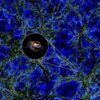The Tarantula Nebula is a star formation region in the Large Magellanic Cloud (LMC). Tarantula is about 160,000 light-years away and is highly luminous for a non-stellar object. It’s the brightest and largest star formation region in the entire Local Group of galaxies.
But it shouldn’t be.
The Tarantula Nebula, also called 30 Doradus, is dominated by a massive cluster of stars in its center called R136. The stars are both young and massive, and when enough of them are concentrated in one area, it’s called a starburst region. R136 qualifies for that distinction. The stars in R136 are so tightly packed that in the scale of distance between our sun and its nearest neighbor, Proxima Centauri, there are tens of thousands of stars.
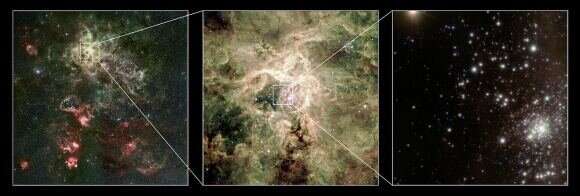
These progressively zoomed-in images of RC136 are from the European Southern Observatory’s Very Large Telescope. The star cluster is 10 million times more luminous than the sun. The brightest star is named R136a1 and is 265 times more massive than our sun, putting it near the top of the list of most massive stars ever found. Image © By ESO/P. Crowther/C.J. Evans – The young cluster RMC 136a, CC BY 4.0, https://commons.wikimedia.org/w/index.php?curid=11013676
Massive young stars consume their hydrogen fuel at a ferocious rate, and they output enormous amounts of energy. That energy shapes the Tarantula Nebula. It’s created expanding bubbles in the gas, one of which is visible in the JWST image below, up and to the left of the central cluster, R136. R136 is responsible for a group of these bubbles.
But there’s abundant weirdness in the center of the Tarantula Nebula. All the stellar radiation from all those intensely energetic stars should be pressurizing the gas in the center. But it’s not. And the center area’s mass is lower than expected. In order for the area to be as stable as it is, it should be more massive. What’s going on?
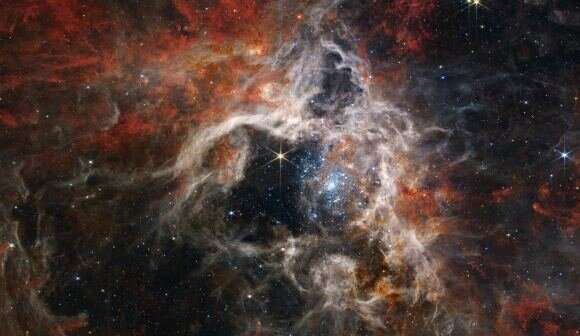
The JWST captured this image of the Tarantula Nebula and its R136 starburst region with its Near-Infrared Camera (NIRCam) instrument. The most active region appears to sparkle with massive young stars, appearing pale blue. Image © NASA, ESA, CSA, STScI, Webb ERO Production Team
In a new paper published in The Astrophysical Journal, researchers explain what’s happening. The paper is “SOFIA Observations of 30 Doradus. II. Magnetic Fields and Large-scale Gas Kinematics.” The lead author is Le Ngoc Tram from the Max Planck Institute for Radio Astronomy.
SOFIA is the Stratospheric Observatory For Infrared Astronomy. The mission has ended now, but it was a converted Boeing 747 with a large infrared telescope fitted inside. SOFIA flew overnight missions where it observed different phenomena in the night sky in the infrared. Infrared observations are difficult from Earth’s surface, and much more effective from space where there’s no intervening atmosphere. SOFIA was an effective way to get above most of Earth’s atmosphere without the expense and complication of launching a space telescope.
SOFIA retired in September 2022 and was a joint mission between NASA and the German Aerospace Center (DLR: Deutsches Zentrum für Luft.) This paper is based on observations gathered before then.
Astronomers used SOFIA’s High-resolution Airborne Wideband Camera Plus (HAWC+) to study the interplay between magnetic fields and gravity in 30 Doradus. Observations show that the magnetic fields in the Tarantula Nebula are responsible for keeping the region together.
“The entire 30 Dor is a complex star-forming region, which clearly shows a core-halo structure, in which there are multiple parsec-scale expanding-shells structures in the outer region and a cloud in the inner region,” the paper states. The stellar wind from all the massive stars, along with supernovae, is responsible for these bubbles.
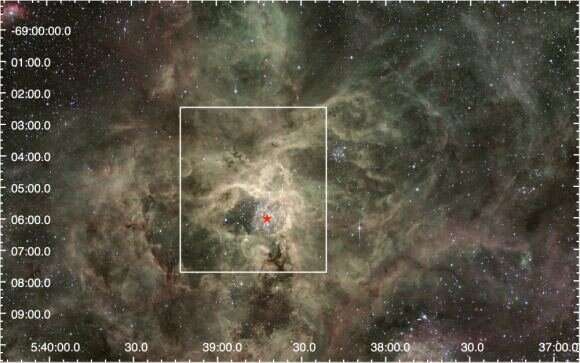
This image from the research shows the complex structure of the region with multiple large expanding shells produced by the hot cluster wind from R136 (indicated by a red star), and a slow expanding shell from the supernova remnant 30DorB (lower right). The white box shows the region covered by SOFIA/HAWC+ that this work covers. © Tram et al. 2023
The heart of 30 Doradus’ weirdness is its turbulence. The powerful stellar winds from the massive stars, combined with energy from supernova explosions, shove the gas in the region around. It should be mayhem, with gas being dispersed and slowing star formation. Since that’s not happening, scientists want to know why.
To find out, the researchers in this work mapped the magnetic fields, known as B-fields in astronomy.
30 Doradus is far too distant for astronomers to directly measure its magnetic fields. But SOFIA is an infrared observatory, so the researchers observed the region in three far infrared wavebands: 89, 154, and 214 μm. Together they created a polarimetric portrait of the gas in the region. They also used CII observations, called the ionized carbon forbidden line, which is at 158 μm and shows fine detail.
The team used their observations and the work of other researchers studying 30 Doradus. They mapped the magnetic fields and the gas velocities in the region to get a clearer look at 30 Doradus. The magnetic fields are inferred from the velocity gradients (VG.)
Their specific goal? “With a distance of ≃50 kpc away from Earth, it is close enough to obtain parsec-scale resolutions to study the impact of the feedback and turbulence on the surrounding molecular cloud,” the authors write.
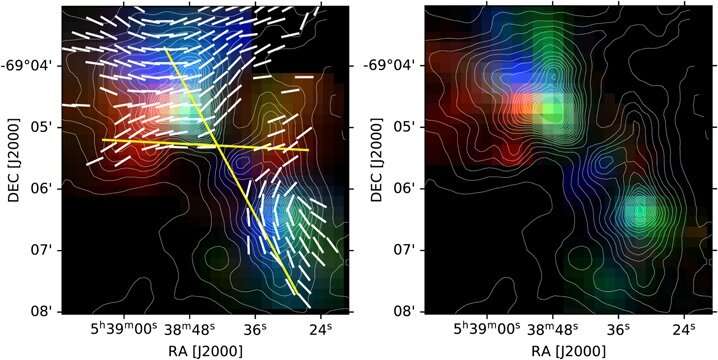
These images from the work are RGB images that help show both the magnetic fields and the movement of gas in 30 Doradus. The white lines in the left panel show the morphology of the magnetic fields. The yellow lines show redshifted and blueshifted gas and their axis. The different colours of gas show their different velocities. The left panel shows the observations for CII, the ionized carbon forbidden line. The right panel is similar to the left but is based on carbon monoxide. © Tram et al. 2023
The team also used their data to chart PV (position-velocity) diagrams and give us a great look at some of the features in the region. The PV diagrams show the position of several different velocity gradients (VG) in the gas. Each velocity gradient shows the location of an expanding bubble in 30 Doradus’ gas.
“These PV diagrams confirm that there are several organized VGs in the region. These gradients cover a velocity interval of 5–15 km s-1 in most PV diagrams and come in the form of curves/half-elliptical features that have been associated with expanding shells,” the authors write.
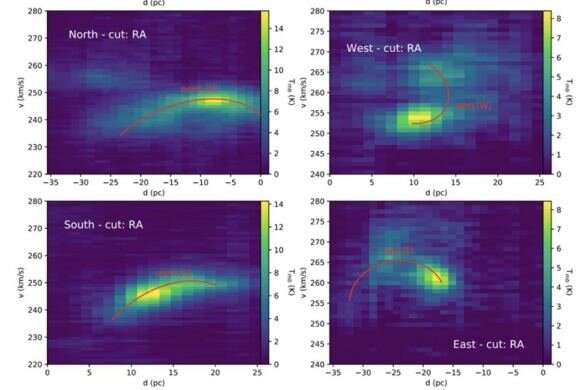
This partial figure from the research shows PV diagrams that indicate four different expanding gas bubbles in 30 Doradus. © Tram et al. 2023
The crux of this work is in the form of a question: “How can we explain the ongoing star formations in strong B-fields?” the authors ask.
“We suspect that B-fields play a crucial role here in holding the cloud integrity,” the authors write in their paper. “The B-field morphology orients perpendicular to the radiation direction so that the magnetic pressure could resist pressure coming from this direction,” they explain. The radiation is the energy coming from the energetic young stars.
It comes down to their strength. They’re strong enough to regulate the flow of gas in the region and keep the entire structure together despite the combined stellar winds from all the young stars. They’re also stronger than the gravity that tries to collapse the gas clouds into even more stars.
But the strength of these fields varies. In some regions, they’re weaker, and that allows gas to move and form the expanding bubbles. Gas is continuously channeled into these bubbles, and inside them, the gas is dense enough to form stars.
Obviously, 30 Doradus is a complex region. With a starburst region, powerful magnetic fields, superheated gas, and bubbles of gas, the region is like a lure to astronomers. “The entire 30 Dor is a complex star-forming region, which clearly shows a core-halo structure, in which there are multiple parsec-scale expanding-shells structures in the outer region and a cloud in the inner region,” the authors explain.
This research helps explain all the goings-on in the part of 30 Dor covered in this study and the role that the magnetic fields play. As far as how these powerful magnetic fields shape the entire nebula, more research is needed to figure that out. “We argue that future polarimetric observations covering a large area in 30 Dor will be necessary to better understand the role of B-fields in the kinematical evolution of the entire 30 Dor region,” the authors write.
What’s still left to establish is the role that the Large Magellanic Cloud’s magnetic fields play. To understand that, the authors say, will require radio wave observations. Astronomers have already gathered some observations of the LMC in radio waves with the Parkes Radio Telescope and the Australia Telescope Compact Array. Those observations showed that the LMC’s magnetic fields are partly shaped by its tidal interactions with the Small Magellanic Cloud.
But those observations weren’t fine enough to reveal the link between the LMC and 30 Doradus.
“More sensitivity and resolution of polarimetric observations at radio wavelengths are needed to better understand the link from the galactic-scale to cloud-scale B-fields,” the authors conclude.
More information:
Le Ngoc Tram et al, SOFIA Observations of 30 Doradus. II. Magnetic Fields and Large-scale Gas Kinematics, The Astrophysical Journal (2023). DOI: 10.3847/1538-4357/acaab0
Citation:
The Tarantula Nebula shouldn’t be forming stars. What’s going on? (2023, June 13)

